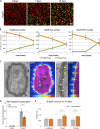Visualization of long-lived proteins reveals age mosaicism within nuclei of postmitotic cells
- PMID: 30552100
- PMCID: PMC6363465
- DOI: 10.1083/jcb.201809123
Visualization of long-lived proteins reveals age mosaicism within nuclei of postmitotic cells
Abstract
Many adult tissues contain postmitotic cells as old as the host organism. The only organelle that does not turn over in these cells is the nucleus, and its maintenance represents a formidable challenge, as it harbors regulatory proteins that persist throughout adulthood. Here we developed strategies to visualize two classes of such long-lived proteins, histones and nucleoporins, to understand the function of protein longevity in nuclear maintenance. Genome-wide mapping of histones revealed specific enrichment of long-lived variants at silent gene loci. Interestingly, nuclear pores are maintained by piecemeal replacement of subunits, resulting in mosaic complexes composed of polypeptides with vastly different ages. In contrast, nondividing quiescent cells remove old nuclear pores in an ESCRT-dependent manner. Our findings reveal distinct molecular strategies of nuclear maintenance, linking lifelong protein persistence to gene regulation and nuclear integrity.
© 2019 Toyama et al.
Figures




Comment in
-
A mosaic of old and young nucleoporins.J Cell Biol. 2019 Feb 4;218(2):385-386. doi: 10.1083/jcb.201811170. Epub 2019 Jan 15. J Cell Biol. 2019. PMID: 30647097 Free PMC article.
References
Publication types
MeSH terms
Substances
Grants and funding
LinkOut - more resources
Full Text Sources
Other Literature Sources

